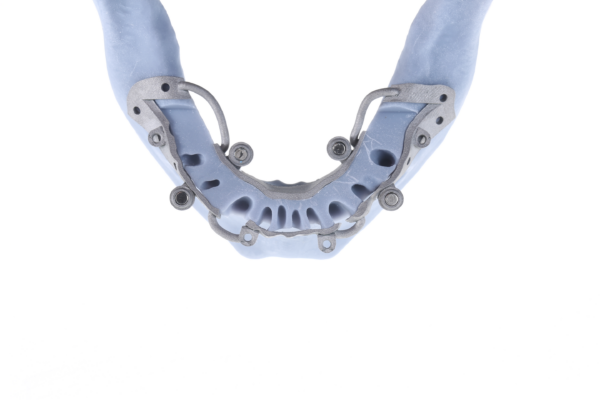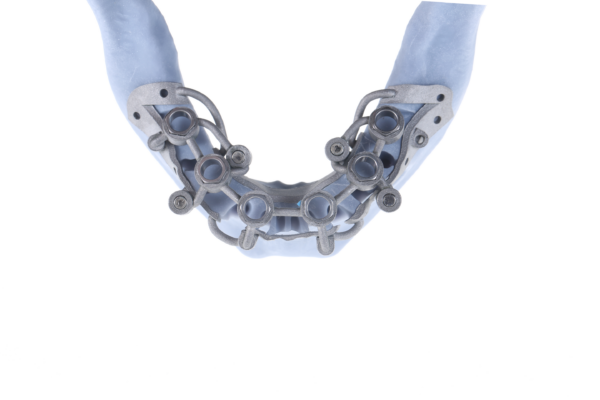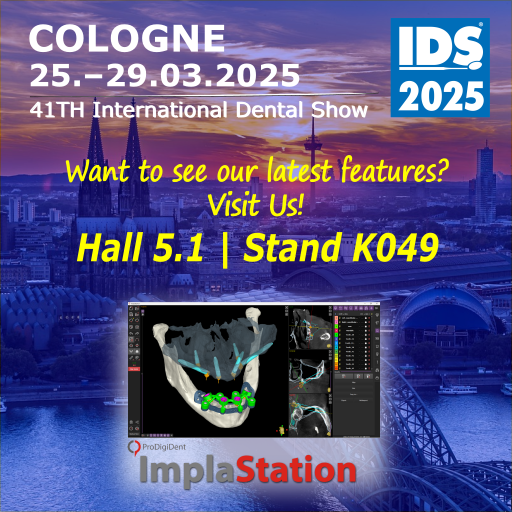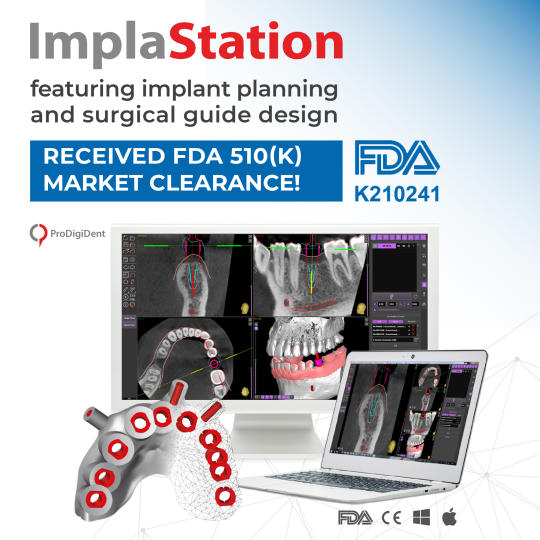Abstract:
Dr. Maxym Prytula’s (UA) case study illustrates a full-arch implant rehabilitation procedure, using the all-on-six methodology complemented by guided alveolar ridge reduction in an edentulous patient with significant mandibular alveolar ridge atrophy. The integration of advanced digital planning tools, specifically ImplaStation software, facilitated precise pre-surgical planning and execution, demonstrating a successful clinical application in dental implantology.
Patient Background and Pre-Surgical Planning Challenges:
A comprehensive pre-surgical evaluation was conducted, incorporating Cone Beam Computed Tomography (CBCT) scans, intra-oral scans, photographs, and diagnostic wax-ups.
The treatment plan included immediate implantation with immediate loading, utilizing the available bone volume for All-on-6 implementation and addressing the correction of the ridge shape in the frontal area. The gingival biotype and atrophied ridge shape did not guarantee stability for the soft tissue-supported surgical guide, whereas bone support offered precise and reliable positioning for both the surgical guide and implants.
Technical Planning and Challenges
Key technical planning steps:
- Integration of CBCT data and optical jaw scans in a single platform.
- Creation of a Wax-Up project incorporating a temporary prosthetic structure for immediate loading.
- Precise bone surface segmentation from CBCT data.
- Virtual implant and abutment placement planning considering bone anatomy and prosthetic requirements.
- Generation of Stackable Surgical Guide for bone reduction and osteotomy.
- Preparation of a temporary prosthetic structure for accurate positioning on abutments.
The utilization of 3D diagnostic information and digital implant planning has become standard practice. However, in complex cases, certain technical stages demand high expertise, substantial effort, and time investment. Specifically in this case:
- Achieving precise digital segmentation of CBCT data into a surface model (STL file) for virtual mandibular bone reconstruction is crucial despite potential artifacts.
- Creating stackable surgical guides necessitates proficiency in multiple software tools for implantation planning, surgical guide design, 3D surface editing, and typically spans several days.
The ImplaStation software streamlined the digital segmentation of CBCT data, bone reduction planning, and implant placement, including the creation of Stackable Surgical Guides.
Surgical Phase and Prosthetic Phase:
The surgery started with flap reflection and roots extraction, followed by placing and securing a “Stackable Guide Fixation Base” for bone reduction guidance. The prepared alveolar ridge was contoured for implant placement. Six implants were then accurately placed using a Osteotomy Guide attached to the Fixation Base.
In the prosthetic phase, a carrier guide aligned the transitional prosthesis accurately over multi-unit abutments (MUAs). Temporary abutments were then secured to the prosthesis, ensuring a precise fit. After adjustments and soft-tissue closure, the prosthesis was immediately loaded, completing the procedure.
The ImplaStation software offered several significant advantages:
- All essential modules in one application.
- ImplaStation’s Wizard-driven Stackable Guide module creates comprehensive set of guides within a 15-minute timeframe.
- The built-in STL surface editor implements any technical solution without extra apps.
Conclusion:
Advanced digital planning tools are an effective solution for complex cases, such as significant atrophy of the alveolar ridge. The use of ImplaStation software in preoperative planning has significantly increased the accuracy and efficiency of both surgical and orthopedic stages, with reasonable time costs, leading to the successful full rehabilitation of the dental arch.




